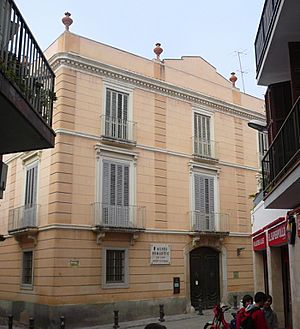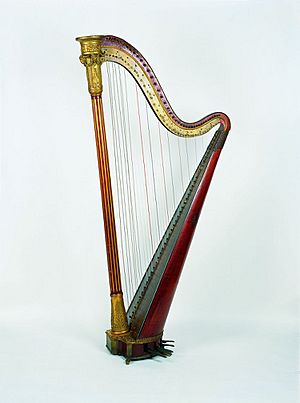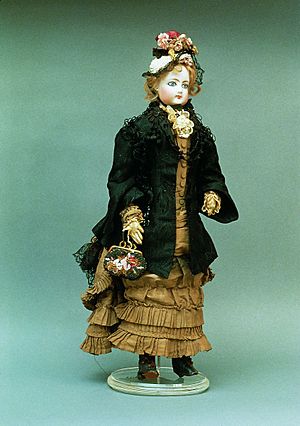Can Llopis Romanticism Museum facts for kids
| Museu Romàntic Can Llopis | |

Can Llopis façade
|
|
| Location | Sitges |
|---|---|
The Can Llopis Romanticism Museum (also known as Museu Romàntic Can Llopis in Catalan) is a cool museum in Sitges. It's inside a beautiful old building built in the Neoclassical style. This museum is part of a bigger group of museums in the Barcelona area.
Contents
History of the Llopis House
The Museu Romàntic is located in what used to be called Casa Llopis. This grand house was built in 1793. At that time, it was outside the old medieval town walls. For many years, it was one of the most impressive homes in the new part of Sitges.
The house belonged to the Llopis family for many generations. They were originally from Sitges and had a background in seafaring. They became very successful by buying land and trading in wines and other drinks.
A Busy Family Home
The Casa Llopis was at its most splendid in the mid-1800s. Back then, Bernardí Llopis i Pujol (1814-1891) owned the house. He was a very important and well-known person in Sitges during the 19th century.
You can even see a cool detail from that time: the local post office was on the ground floor of the mansion! There's a letter box shaped like a lion with its mouth open right next to the front door.
Becoming a Museum
In 1935, the last person in the family to own the house was Manuel Llopis de Casades. He was a diplomat. He decided to give the family home to the Generalitat de Catalunya (the Catalan Government). His wish was for it to become a museum.
However, the Spanish Civil War started, and this plan was put on hold. Later, in 1943, the people in charge of Manuel's will offered the house to the Provincial Deputation of Barcelona. After some repairs, the main rooms on the first floor opened to the public in 1949. Later, the ground-floor rooms, the garden, and even the old wine cellars and library were also opened.
What You Can See at the Museum
The outside of the museum building looks quite simple. But inside, it's full of color and life! When you step inside, it feels like you've traveled back in time. You can imagine what daily life was like for a wealthy family in the 1800s.
Rooms Full of Treasures
On the main floor, you'll find different rooms like a music room, a ballroom, a dining room, and bedrooms. Each room is filled with beautiful furniture from different styles of the time. You can also see amazing items like Meissen porcelain and glass from Murano and Bohemian glass.
There are also musical instruments, old clocks, and many personal items. You can even see how lighting changed during the 19th century. They used everything from oil lamps to the first gas lights.
Special Areas to Explore
The gallery on the first floor and the garden are some of the most charming parts of the house. In the gallery, two walls are decorated with fun scenes of children. On the floor, there's a special game called "Bis Bis" from the time of Napoleon. It's made of 49 colorful tiles that the Llopis family and their guests used to play with.
The cellar is also very interesting. This is where the Llopis family made their famous Malvasia wine. Today, the Hospital de Sant Joan Baptista owns the Malvasia brand. They also own the vineyards that the last Llopis family member gave them. This was on the condition that they would keep growing and making the special Sitges Malvasia wine.
Lola Anglada's Doll Collection
The second floor of the museum used to be where the staff lived. Since the 1970s, it has been home to a wonderful collection of dolls and toys. This collection belonged to the famous writer and illustrator Lola Anglada. She gave it to the museum.
The collection has more than 400 items. Some are from the 1600s, and many more are from the 1700s and 1800s. The dolls are made from different materials like wood, papier-mâché, and porcelain. There are even some clockwork dolls that can play music and move!
Lola Anglada didn't collect these dolls just to find rare ones. She wanted to bring back the feeling of how people lived in the 19th century. She saw the poses and clothes of these dolls as a way to remember a lost time.
See also
 In Spanish: Museo Romántico Can Llopis para niños
In Spanish: Museo Romántico Can Llopis para niños
- Maricel Museum
- Can Papiol Romanticism Museum



